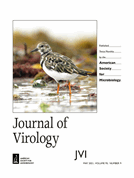Abstract Genetic recombination is one of the major evolution processes of HIV-1. Despite their great genetic divergence, HIV-1 groups M and O can generate HIV-1/MO intergroup recombinants. The current description of 20 HIV-1/MO unique recombinant forms suggests a possible benefit of the recombination. The aim of this work was to study in vitro the replicative… Continue reading In vitro replicative potential of an HIV-1/MO intergroup recombinant virus compared to HIV-1/M and HIV-1/O parental viruses
Tag: Viral Genetics and Evolution
Longitudinal profiling identifies co-occurring BRCA1/2 reversions, TP53BP1, RIF1 and PAXIP1 mutations in PARP inhibitor resistant advanced breast cancer
AI SummaryResistance to therapies that target homologous recombination deficiency (HRD) in breast cancer is a problem. The existence and frequency of resistance mechanisms in clinical disease are unclear, as well as how to overcome resistance.Resistance to therapies that target homologous recombination deficiency (HRD) in breast cancer limits their overall effectiveness. Multiple preclinically-validated mechanisms of resistance… Continue reading Longitudinal profiling identifies co-occurring BRCA1/2 reversions, TP53BP1, RIF1 and PAXIP1 mutations in PARP inhibitor resistant advanced breast cancer
Systematic detection of co-infection and intra-host recombination in more than 2 million global SARS-CoV-2 samples
Abstract Systematic monitoring of SARS-CoV-2 co-infections between different lineages and assessing the risk of intra-host recombinant emergence are crucial for forecasting viral evolution. Here we present a comprehensive analysis of more than 2 million SARS-CoV-2 raw read datasets submitted to the European COVID-19 Data Portal to identify co-infections and intra-host recombination. Co-infection was observed in… Continue reading Systematic detection of co-infection and intra-host recombination in more than 2 million global SARS-CoV-2 samples
Recombination-aware phylogenetic analysis sheds light on the evolutionary origin of SARS-CoV-2
Abstract SARS-CoV-2 can infect human cells through the recognition of the human angiotensin-converting enzyme 2 receptor. This affinity is given by six amino acid residues located in the variable loop of the receptor binding domain (RBD) within the Spike protein. Genetic recombination involving bat and pangolin Sarbecoviruses, and natural selection have been proposed as possible… Continue reading Recombination-aware phylogenetic analysis sheds light on the evolutionary origin of SARS-CoV-2
An evolutionary perspective on complex neuropsychiatric disease
Members of the NIMH Network for Studies of Mental Disorders in Ancestrally Diverse Populations illuminate the genetic architecture of complex neuropsychiatric illnesses in the context of forces of evolution: mutation, selection, migration, and genetic drift/population structure.
Puzzles, challenges, and information reservoir of SARS-CoV-2 quasispecies
A recombination-resistant genome for live attenuated and stable PEDV vaccines by engineering the transcriptional regulatory sequences
1460 PP2Ac deficiency enhances tumor immunogenicity by activating STING-Type I interferon signaling in glioblastoma
Background Glioblastoma (GBM) is an immunologically ‘cold’ tumor that does not respond to current immunotherapy. Low immunogenicity of GBM with minimal MHC-I expression and paucity of T cells infiltration are major barriers for effective immune checkpoint blockade (ICB).1–4 PP2A is a major protein phosphatase that account for 50% to 70% of the total serine/threonine phosphatase… Continue reading 1460 PP2Ac deficiency enhances tumor immunogenicity by activating STING-Type I interferon signaling in glioblastoma
1405 Comparative analysis of complete blood count, serum chemistry and immune phenotype between SRG and CD rats
AI SummaryThe study compares the immune characteristics of immunodeficient SRG rats with control CD rats. It found that SRG rats have reduced levels of T, B, and NK cells, but similar levels of monocytes. SRG rats also have increased complement activity compared to CD rats. The study concludes that these findings enhance our understanding of… Continue reading 1405 Comparative analysis of complete blood count, serum chemistry and immune phenotype between SRG and CD rats
1101 Activation of myeloid cells suppresses metastatic ovarian cancer via tumoricidal neutrophils and IL-27-secreting macrophages
AI SummaryResearchers have developed a novel immunotherapy that activates myeloid cells to eradicate metastatic ovarian cancer (OC). Using β-glucan and interferon (IFN), the study found that combining these treatments cleared ascites and reduced total metastases in mice. This therapy required T cells and non-tumor IFN signaling in the host. The activation of myeloid cells led… Continue reading 1101 Activation of myeloid cells suppresses metastatic ovarian cancer via tumoricidal neutrophils and IL-27-secreting macrophages

